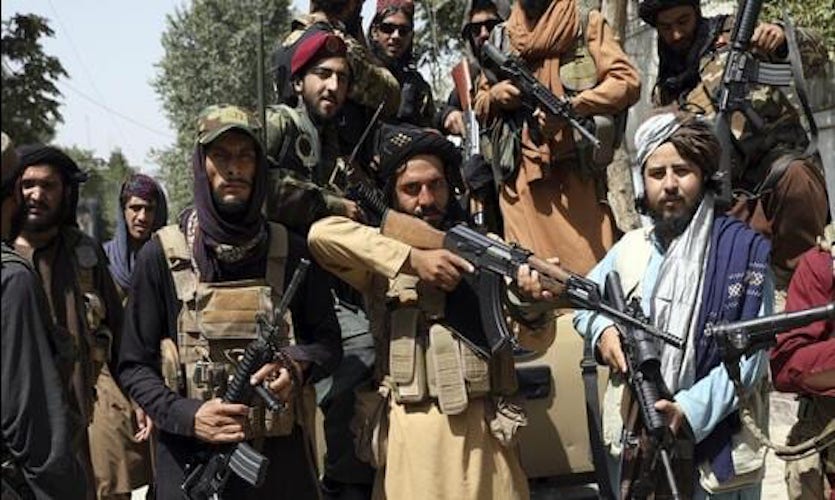According to a report by the United Nations Security Council, Pakistan-based terror groups Jaish-e-Mohammed (JeM) and Lashkar-e-Taiba (LeT) still have hundreds of fighters in Afghanistan. Additionally, both the groups maintain at least 11 terrorist training camps in the Kunar and Nangarhar provinces of Afghanistan. The report also indicated that these camps have deep links with the ruling regime, and regular meetings with the top state officials.
The 13th report by the Analytical Support and Sanctions Monitoring Team, which assists the UN Security Council’s 1988 Sanctions Committee, was released earlier this week. This is also the first report by the monitoring team since the Taliban took over Afghanistan. According to the report, “JeM maintains eight training camps in Nangarhar, three of which are directly under Taliban control.” Furthermore, the LeT has maintained three camps in Kunar and Nangarhar, and have also provided finance and training expertise to Taliban operations earlier.
This report has been circulated within the 15-member UNSC Sanctions Committee that is currently chaired by India, with Russia and UAE as the vice-chairs. The report provides guidance for the UN’s future strategy with regard to Afghanistan. According to the UN report, the LeT (formed in Afghanistan in 1990) has maintained close relations with the Taliban leadership. As of October 2021, LeT leader Mawlawi Assadullah met the Taliban’s Deputy Interior Minister Noor Jalil, as reported by one of the member states. Additionally, in January 2022, the same member state reported a Taliban delegation visiting a training camp by the LeT in the Haska Mena district, in Nangarhar province.
The LeT has reportedly maintained three camps in the two aforementioned provinces of Kabul. “Previous LeT members have included Aslam Farooqi and Ejaz Ahmad Ahangar (a.k.a. Abu Usman al-Kashmiri), both of whom joined ISIL-K,” states the report.
According to the report, JeM, a Deobandi group led by Masood Azhar, is “ideologically closer” to the Taliban. Qari Ramazan is the newly appointed head of the JeM in Afghanistan. The report added that the LeT in Afghanistan is led by Mawlawi Yousuf. Meanwhile, one member state indicated in the report that there was no evidence of the presence of JeM and LeT in the region as a consequence of effective security operations targeting them. On the other hand, the report says that the Taliban “appear confident” in their ability to control Kabul while they “wait out” the international community to obtain recognition of them as a government.
The UN report has further indicated that a change in the name of the Al Qaeda in Indian Subcontinent (AQIS) magazine “suggests a refocusing” of the terror group from Afghanistan to Kashmir. The AQIS is a subordinate of the Al-Qaeda, and has been operating in Afghanistan, where most of its fighters are. The report states that the AQIS has between 180 to 400 fighters in Kabul which include nationals from countries like “Bangladesh, India, Myanmar and Pakistan…located in Ghazni, Helmand, Kandahar, Nimruz, Paktika and Zabul Provinces”.
Reportedly, while the Al-Qaeda “enjoys greater freedom under the new Afghan regime”, they are “unlikely” to conduct direct attacks outside Afghanistan for at least a year or two “owing to both a lack of capability and Taliban restraint”. Additionally, the report added how the capabilities of the AQIS are “still weakened” owing to the October 2015 joint US-Afghan raid in Kandahar’s Shorabak district. On the other hand, the strength of groups like the Islamic State in Iraq and the Levant-Khorasan (ISIL-K) has also reportedly declined.
“As with Al-Qaeda core, new circumstances in Afghanistan may allow the group to reorganise itself. The 2020 name change of the AQIS magazine from ‘Nawa-i Afghan Jihad’ to ‘Nawa-e-Gazwah-e-Hind’ suggests a refocusing of AQIS from Afghanistan to Kashmir,” added the report. “The magazine reminded its readers that al-Zawahiri had called for “jihad” in Kashmir following the Da’esh Sri Lanka attacks of April 2019,” says the report, nine months after the Taliban took over Afghanistan in August last year.
Amid this, member states have also indicated that interdictions of Afghan-origin drugs increased significantly in the second half of 2021. “Three tonnes of Afghan-origin heroin were seized in India in September 2021. One member state reported that smuggling via the Islamic Republic of Iran to Turkey and Europe has increased by up to 50% since the Taliban assumed power,” stated the report, which suggests either the failure of counter-narcotics efforts within Afghanistan, or increased activity anticipating the ban.
Additionally, the ISIL-K have reportedly concentrated their attacks on the Taliban after their takeover of Afghanistan. Their decline in activity could be attributed to the winter weather. On the other hand, the report also details the internal power struggle within the Taliban for the first time. At least 180 senior Taliban members reportedly travelled for a three-day jirga in Kandahar with Taliban leader Haibatullah Akhundzada, from March 22 to 24.
According to the report, “The gathering revealed some divisions within the movement, as consultations on key policy decisions ended with Hibatullah backing the decision to ban girls’ education.” It added, “The foremost internal division within the Taliban has been defined by opposing views between moderate and hardline blocs.” Taliban leaders belonging to hardline blocs want to follow a more “ideological” approach, and put less emphasis on their relations with the international community.
Read more: How Is The ‘Neighbourhood First’ Policy In India’s Interest?
The report also suggests that the Al-Qaeda leadership under Aiman Muhammed Rabi al-Zawahiri is reported to remain in the eastern region of Afghanistan which borders Pakistan. Since August 2021, al-Zawahiri has appeared in eight videos. Referring to the hijab row in India, the report said that the most recent video of al-Zawahiri was released by Al-Qaeda’s As-Sahab Media Foundation, on April 5. In this video, al-Zawahiri references the defiance of an Indian Muslim female in front of men protesting the hijab, an event that went viral in early February 2022.
In reference to the ISIL-K, the member states have estimated that at least 1,500 to 4,000 fighters are concentrated in Kunar, Nangarhar and possibly Nuristan province, with smaller groups in four northern provinces. The report also indicates how historically, the geographical distance and ethnic differences may have led to various ISIL-K groups struggling to coordinate with each other.
Additionally, the report also refuted the Taliban’s claims of not allowing the use of Afghan soil to foreign fighters, as it found several groups like the Eastern Turkistan Islamic Movement, the Islamic Movement of Uzbekistan, and the Jamaat Ansarullah still active in Kabul, with groups of at least a few hundred fighters each.










